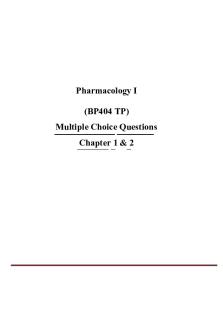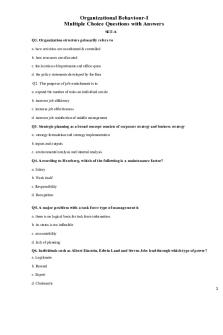MCQ U I MC SET I - MCQ Test Questions PDF

| Title | MCQ U I MC SET I - MCQ Test Questions |
|---|---|
| Course | Mobile Computing |
| Institution | Anna University |
| Pages | 3 |
| File Size | 75.5 KB |
| File Type | |
| Total Downloads | 109 |
| Total Views | 147 |
Summary
MCQ Test Questions...
Description
QP CODE: 8601/1/A
TIME: 30 min
REG. NO. SRIRAM ENGINEERING COLLEGE B.E/B.TECH. OBJECTIVE TYPE EXAMINATION – UNIT 1 III Year/ VI Semester DEPERTMENT OF COMPUTER SCIENCE AND ENGINEERING CS8601/MOBILE COMPUTING (Regulations 2017) Answer ALL questions Maximum: 50 Marks (TICK THE CORRECT ANSWER) Part-A (25 x 2=50 Marks)
1. Multiple access schemes are used to allow ____ mobile users to share simultaneously a finite amount of radio spectrum. a) Many b) One c) Two d) Ten-Fifteen 2. The technique that makes possible the task of listening and talking in communication system is called ________ a) Simplexing b) Duplexing c) Modulating d) Multiple access technique 3. Frequency division duplexing provides ____ distinct bands of frequencies for _____ user. a) Two, two b) One, two c) Two, one d) Two, many
4. Time division duplexing uses ____ to provide both a forward and reverse link. a) Frequency b) Time c) Time and frequency d) Cell spacing 5. TDD is effective for _____ a) Fixed wireless access and users are stationary b) Dynamic wireless access and users are stationary c) Fixed wireless access and users are moving d) Dynamic wireless access and users are moving 6. In wideband systems, the transmission bandwidth of a single channel _____ coherence bandwidth of the channel. a) Equal to b) Not related to c) Larger than d) Smaller than 7. Frequency division multiple access (FDMA) assigns ______ channels to _______ users. a) Individual, individual b) Many, individual c) Individual, many d) Many, many 8. The FDMA channel carries ____ phone circuit at a time. a) Ten b) Two c) One d) Several
9. The bandwidth of FDMA channel is ______ a) Wide b) Narrow c) Large d) Zero 10. The symbol time in FDMA systems is _________ thus intersymbol interference is ______ a) Large, high b) Small, low c) Small, high d) Large, low 11. Due to _________ transmission scheme, ______ bits are needed for overhead in FDMA systems. a) Continuous, few b) Discontinuous, few c) Continuous, many d) Discontinuous, many
12. Which of the following is not true for FDMA systems as compared to TDMA systems? a) Low complexity b) Lower cell site system cost c) Tight RF filtering d) Narrow bandwidth 13. __________ is undesired RF radiation. a) Intermodulation frequency b) Intermediate frequency c) Instantaneous frequency d) Instrumental frequency 14. ______ is based on FDMA/FDD. a) GSM b) W-CDMA c) Cordless telephone d) AMPS 15. Preamble contains _____ a) Address b) Data c) Guard bits d) Trail bits 16. _____ are utilized to allow synchronization of the receivers between different slots and frames. a) Preamble b) Data c) Guard bits d) Trail bits 17. Which of the following is not true for TDMA? a) Single carrier frequency for single user b) Discontinuous data transmission c) No requirement of duplexers d) High transmission rates 18. Because of _______ transmissions in TDMA, the handoff process in _____ a) Continuous, complex b) Continuous, simple c) Discontinuous, complex d) Discontinuous, simple 19. _____ synchronization overhead is required in TDMA due to _______ transmission. a) High, burst b) High, continuous c) Low, burst d) No, burst 20. ______ of TDMA system is a measure of the percentage of transmitted data that contains information as opposed to providing overhead for the access scheme. a) Efficiency b) Figure of merit c) Signal to noise ratio d) Mean 21. A TDMA system uses 25 MHz for the forward link, which is broken into radio channels of 200 kHz. If 8 speech channels are supported on a single radio channel, how many simultaneous users can be accommodated? a) 25 b) 200 c) 1600 d) 1000 22. What is the time duration of a bit if data is transmitted at 270.833 kbps in the channel? a) 270.833 s b) 3 μs c) 3.692 μs d) 3.692 s 23. PN sequence converts _______ signal to ______ signal. a) Narrowband, wideband b) Wideband, narrowband c) Unmodulated, modulated d) Low frequency, high frequency 24. ______ is a digital multiple access system in which carrier frequencies are varied in pseudorandom order. a) CDMA b) FCDMA c) FHMA d) SDMA 25. If the rate of change of the carrier frequency is greater than the symbol rate, then the system is referred as ______ a) Fast frequency hopping system b) Slow frequency hopping system c) Time division frequency hopping system d) Code division multiple access system TOTAL MARKS OBTAINED:
SIGNATURE OF FACULTY...
Similar Free PDFs

MCQ - Family Law I
- 20 Pages

Ch05 mcq - mcq test bank
- 9 Pages

Signal & System UNIT I MCQ
- 18 Pages

Mcq Of Pharmacology I-BP404TP
- 34 Pages

PHP MCQ QBank - PHP MCQ set
- 15 Pages

Organizational Behaviour MCQ SET
- 20 Pages

Bsc mcq set 3
- 9 Pages

BSc mcq set 5
- 11 Pages

Macro Economics mc - Model MCQ test
- 22 Pages

Mcq - mcq
- 9 Pages

MCQ - MCQ
- 16 Pages

Forensic MCQ Set 1 - Good
- 6 Pages
Popular Institutions
- Tinajero National High School - Annex
- Politeknik Caltex Riau
- Yokohama City University
- SGT University
- University of Al-Qadisiyah
- Divine Word College of Vigan
- Techniek College Rotterdam
- Universidade de Santiago
- Universiti Teknologi MARA Cawangan Johor Kampus Pasir Gudang
- Poltekkes Kemenkes Yogyakarta
- Baguio City National High School
- Colegio san marcos
- preparatoria uno
- Centro de Bachillerato Tecnológico Industrial y de Servicios No. 107
- Dalian Maritime University
- Quang Trung Secondary School
- Colegio Tecnológico en Informática
- Corporación Regional de Educación Superior
- Grupo CEDVA
- Dar Al Uloom University
- Centro de Estudios Preuniversitarios de la Universidad Nacional de Ingeniería
- 上智大学
- Aakash International School, Nuna Majara
- San Felipe Neri Catholic School
- Kang Chiao International School - New Taipei City
- Misamis Occidental National High School
- Institución Educativa Escuela Normal Juan Ladrilleros
- Kolehiyo ng Pantukan
- Batanes State College
- Instituto Continental
- Sekolah Menengah Kejuruan Kesehatan Kaltara (Tarakan)
- Colegio de La Inmaculada Concepcion - Cebu



